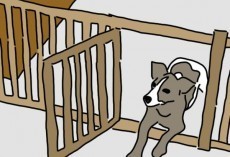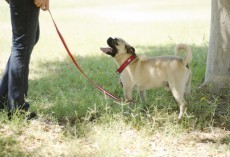First and foremost, Fido needs to know you are his pack leader. If you've been lax with training him and showing him that you're in charge, it's better to start now rather not at all. As soon as he knows you are his leader he will be more willing to look to you when he's feeling anxious.
Territorial aggression is a potentially dangerous behavior problem. In mild form, dogs bark to intimidate intruders, particularly those of the same species. And if this is ineffective in deterring the visitor, an attack may ensue.
Although alarm barking can sometimes be aggravating for dog owners, neighbors, and visitors, lunging and biting are far more serious problems. Dogs with the confidence to bite strangers present a danger to any visitors to the home and a liability for the dog's owners.
When dogs display aggression to strangers only on the home property, and do not respond aggressively to strangers on neutral territory, territorial aggression is the likely diagnosis. There are two primary motivations for territorial behavior, dominance or fear/anxiety.
Territorial Aggression Fueled by Dominance
Dominant dogs have a responsibility to warn other pack members of a stranger's approach and they do this with confidence and authority.There are several factors that distinguish fear-related territorial aggression from dominance-driven aggression.
1. Territorial/fear aggressive dogs frequently show ambivalent body language similar to that of purely fear aggressive dogs.
2. Territorial/fear aggressive dogs do not usually settle down completely while visitors are in the home and are prone to sudden outbursts of barking or lunging.
3. The bites of territorial fear aggressive dogs are usually directed towards the “nether regions” of the offender (e.g. toward the person's buttocks, thighs, or calves).
4. In a way, the only distinguishing feature between territorial fear aggression and overt fear aggression is the level of confidence that the dogs possess.Although dominance-based territorial aggression is easier to manage than fear-based territorial aggression, both forms of territorial aggression can be addressed reasonably well by means of management measures, proper control, and containment.
Safety Precautions. Owners should keep doors secured to ensure that no one enters the property without warning. Finally, owners should consider posting a “Beware of Dog” sign as a responsible reminder that a dog is on the property.
Medical Rule-outs. Consider testing the dog for medical conditions that might be contributing to increased anxiety, especially hypothyroidism. Borderline-low levels of the principal thyroid hormone may be associated with increased anxiety, and thus aggression.
The approach we advocate is the “Nothing in Life is Free” leadership program. This requires the dog to work for anything he needs or desires (food, toys, attention, access to the outdoors etc.). In effect he must “earn” all valued resources by first obeying a command. If the dog learns to respect his owners in this way, he will be more likely to turn to them for direction when he's feeling challenged or fearful.
Until your pup is doing better at not showing aggressive behavior, you can give him more privileges such as not leashing him up when visitors arrive. Helping him learn commands by getting nothing for free as well as applying other tips from Pet Place is one of the first steps you can do to help him. That way he won't feel he always dominant over people and places.
You never want to put your friends and family members in harm's way so do your best to read your doggy's mood and be patient with him. Yelling at him and punishing him will only make matters worse. With the proper training and desensitization, Fido should be on his way to aggression recovery.










